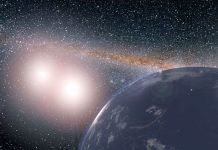
Scientists have discovered that the universe makes a sound. Think of it like a very low hum. This hum is caused by something called gravitational radiation.
Gravitational radiation is a lot like waves in the ocean, but instead of water moving, it’s space itself that’s stretching and squeezing.
Imagine stretching and squeezing a rubber band; that’s what the universe is doing, but in a much bigger way.
How We Found Out About The Hum
A group of researchers has been studying stars known as millisecond pulsars for over 15 years. These stars have a steady rhythm.
But, the scientists found that sometimes the rhythm changes a little. This change, they believe, is caused by the hum of the universe.
In 2015, another device detected waves in space, but those were made by smaller black holes merging together. Now, scientists are asking if bigger waves, the kind that cause the hum, are also made by black holes.
The research group, NANOGrav, believes that the hum might be caused by giant black holes coming together.
These black holes are so big that they have the weight of billions of suns. Imagine two dancers spinning on a dance floor. As they get closer and closer, they start to shake the floor.
These giant black holes are like the dancers, and the space around them is like the floor. When they get close to each other, they shake up space and create the hum.
However, there’s still a mystery. Scientists aren’t completely sure that the hum is from these giant black holes.
If it is, it would be the first real proof that such giant black hole pairs exist. This has been a big question in science for over 50 years.
The Bigger Picture
Some other scientists think that the hum might be caused by other things like dark matter, leftover black holes from the universe’s start, or cosmic strings.
To be sure about the hum’s source, scientists need to see how the hum changes in different parts of the sky.
When galaxies come together, their central black holes should also come close to each other. These black holes then start going around each other.
But for the hum to happen, these black holes need to get really, really close, much closer than the Earth is to the sun.
One problem scientists have had for a long time is understanding how these black holes can get that close. They know that galaxies can push black holes close together, but they need to get even closer to create the hum.
It’s like two people wanting to shake hands but standing far apart. They need to walk towards each other to shake hands, but what makes the black holes come that close?
Data from NANOGrav suggests that most of these big black hole pairs do get close enough to cause the hum. How? That’s still a question.
To learn about the hum, scientists use special stars known as millisecond pulsars. These stars send out regular signals.
But, if space is stretched or squeezed, the signals will change slightly. By watching these changes, scientists can learn more about the universe’s hum.
Researchers from different parts of the world are also looking at these stars to understand the hum. They all want to figure out more about the black holes and how they might be causing the hum.
The universe is like a big instrument that’s playing a tune. This tune or hum might be the sound of giant black holes dancing together.
As scientists learn more, they get more excited about the stories that space has to tell. They will keep listening to the universe’s hum and hope to solve the mystery behind it.
The study was published in The Astrophysical Journal Letters.



